The new Austrian Bundesliga season is upon us, with Red Bull Salzburg getting life under ex-Liverpool assistant coach Pep Lijnders off to a positive start in game one of the new league campaign by earning three points, albeit a hard-fought three points, against newly-promoted Grazer AK — local rivals of last season’s league title winners, SK Sturm Graz.
At the time of writing, Salzburg and Grazer are the only two sides of the Austrian Bundesliga’s 12 to officially get the new campaign started, with defending champions Sturm Graz not set to kick off 2024/25 until Sunday, when they travel to Allianz Stadion to face Rapid Wien.
The new Austrian top-flight campaign is set to play host to an intriguing battle at the top of the table.
On one side, we find SK Sturm Graz, who had finished second in the league for two years in a row under Christian Ilzer until the 46-year-old coach finally brought the title to Die Schwoazn this past season — delivering Sturm Graz a first championship since 2010/11.
Now, Ilzer faces the fresh challenge of spearheading the hunted, as opposed to the hunters, as he prepares his Schwoazn side to try and defend their Bundesliga crown.
On the other side, we find a Red Bull Salzburg side coming into the new season not as the defending champions for the first time since 2013/14 — a campaign which kickstarted a 10-year title streak.
Under Jürgen Klopp protégé Pep Lijnders, they’re coming into 2024/25 to make up for last season’s domestic disappointment, kick Sturm Graz off the league’s summit and re-establish themselves as Austria’s team to beat.
This tactical analysis piece provides some analysis of both sides’ tactics in and out of possession, sharing some insight into what can be expected from them in this 2024/25 campaign, which has the potential to see an intriguing title race.
Transfer Window Overview
Firstly, for a little bit of context, let’s take a moment to discuss how these two teams approached the 2024 summer transfer window.
Salzburg and Sturm Graz experienced very different transfer windows this summer, with the former being the most profitable side in Austria’s top-flight (+€28.2m) when it comes to transfer fees at the time of writing and the latter being the biggest spenders in that category (-€3.64m).
Salzburg have parted ways with some notable members of their 2023/24 squad, including Strahinja Pavlović, who’s joined AC Milan, Luka Sučić, who’s joined Real Sociedad, and Sékou Koïta, who’s joined CSKA Moscow.
As of yet, the only players they’ve signed are Janis Blaswich — a goalkeeper signed on loan from RB Leipzig — and Takumu Kawamura — a midfielder signed for an undisclosed fee from J1 League side Sanfrecce Hiroshima.
This is hardly an investment in the playing squad, which provides the resemblance of a side gearing up to avenge a title loss last term, but considering the potentially major addition of Lijnders in the dugout and the elite youth system at his disposal — a result of years of hard work and, indeed, investment — transfer fees are not the only things that should be considered when it comes to assessing Salzburg’s readiness for the 2024/25 season and the challenges it brings.
Several players have been promoted within the squad from lesser roles last season to more significant ones this term and some players have been promoted from youth ranks to the senior squad, adding fresh blood for Lijnders to get his hands on and work with.
Salzburg still boast by far the most valuable squad in the Austrian Bundesliga, per Transfermarkt, and the biggest wage bill in Austria’s top flight, per Capology.
Hence, they are very much a force to be reckoned with by any measure.
On the other hand, Sturm Graz have ensured they didn’t become a lot weaker this season by bringing in a couple of key loanees from last term — Mika Biereth from Arsenal and Dimitri Lavalée from KV Mechelen — back to the club on permanent deals.
They also replaced departing left-back David Schnegg, who’s gone to MLS side DC United, with Emir Karić, who joined on a free after previously playing for Darmstadt in the German Bundesliga last term.
On top of that, they’ve invested heavily in top youth prospects, with Emanuel Aiwu (23 years old) joining from Cremonese for €1.6m, Arjan Malić (18 years old) joining from SV Ried for €650K, Daniil Khudyakov (20 years old) joining from Lokomotiv Moscow for €340K, Tochi Chukwuani (21 years old) joining from Lyngby BK for €200K, Martin Kern (18 years old) joining from Puskás AFC for an undisclosed sum and Lovro Zvonarek (19 years old) joining on a season-long loan from FC Bayern.
If there was any concern of complacency creeping into Ilzer’s squad, this vast injection of promising youth talent should address it.
A plethora of hungry youngsters are now going to be in the squad and chomping at the bit to create their own bit of history at Merkur Arena.
Sturm Graz Out-Of-Possession
Moving on to the Sturm Graz tactical analysis, we’ll start by discussing both sides’ respective approaches in defensive phases.
Firstly, let’s look at the defending champions, Sturm Graz.
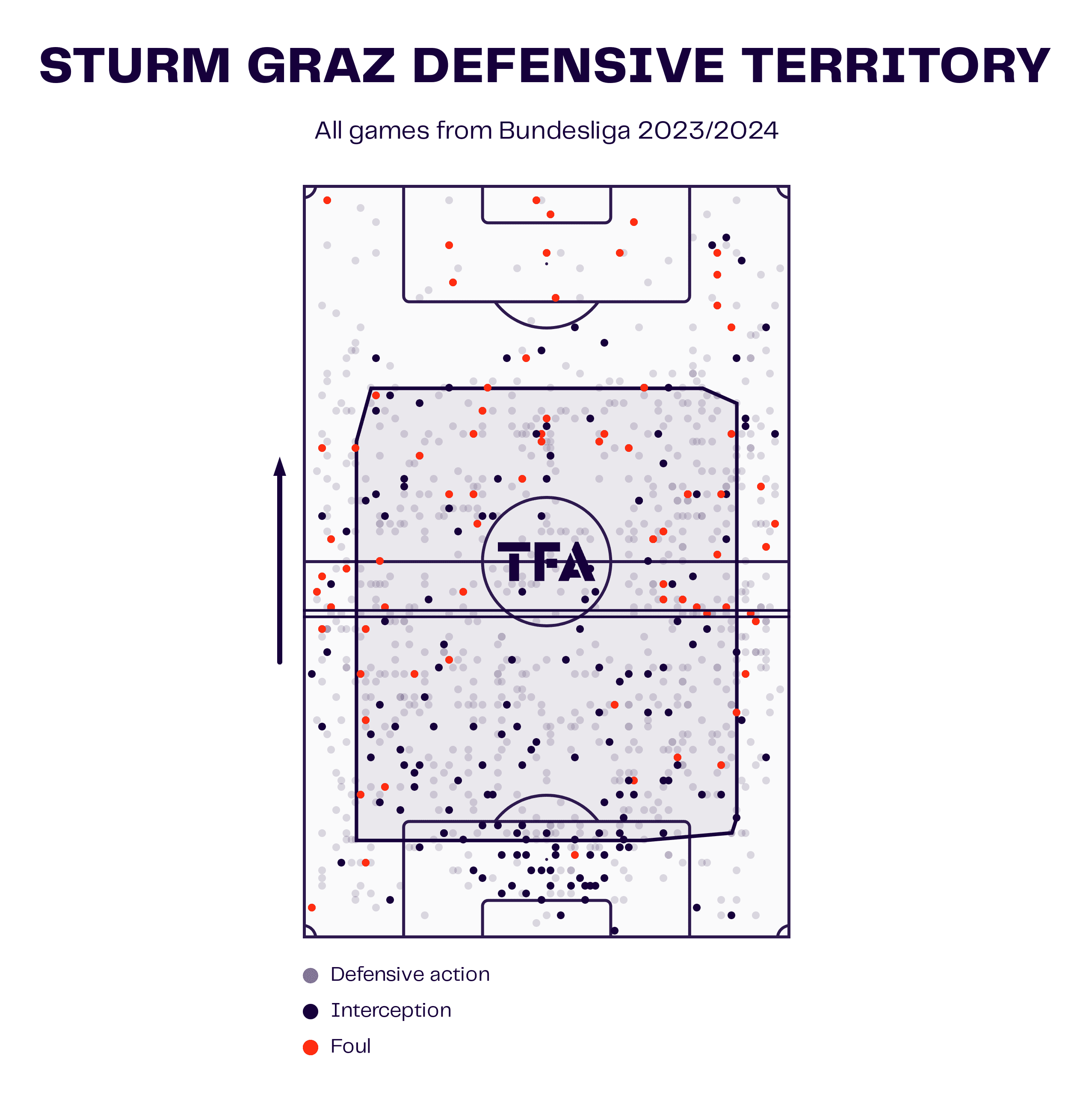
Last season, Sturm Graz had the fourth-lowest PPDA (8.58) in Austria’s top flight.
They tend to press fairly aggressively with quite a high line, yet still, there are teams in Austria’s top flight, including Salzburg, who had the lowest PPDA in the league last term (7.24) with an even more aggressive press.
However, no team conceded fewer goals (23) than Ilzer’s team in 2023/24, which shows yet again that defences do, in fact, win titles.
Meanwhile, Sturm Graz had the second-lowest expected goals against (35.95) for 2023/24, which is quite a bit higher than their actual goals against but still ranks relatively impressively among their domestic competition.
Ilzer typically sets his Sturm Graz side up in a 4-diamond-2 shape.
Without the ball, this obviously tends to give Sturm Graz quite a strong presence in the middle of the park, which can be difficult for teams to play through. This forces their opponents to try and either go around their block, play via the wings, or over the top with a long ball.
When they force their opponents out wide, their press will typically increase in intensity, with the full-back on that side jumping to press high while the central diamond will also shift over, as a unit, to congest the space and increase pressure on that wide ball carrier.
This can leave some space on the opposite side for the opposition to potentially exploit via a switch of play.
In addition, if all the midfielders’ spacing is not perfect and/or one of the Sturm Graz midfielders is overloaded with a 2v1 decision to make, the opponent can use this shifting out towards the wing to their favour and find an opportunity to play through Sturm Graz centrally.
In general, though, Ilzer has created quite a strong defensive structure, which involves his forwards and midfielders pressing the opposition right from their build-up. This proved quite effective in their title-winning 2023/24 campaign.
When it comes to defensive transitions, a special mention has to be made for Ilzer’s lethal counterpress.
Last season, Sturm Graz generated 640 counterpressing recoveries in the Austrian Bundesliga — 51 more than Red Bull Salzburg, who’d also consider counterpressing a key tactical phase.
Ilzer’s effective counterpress was vital to his side’s league success last term and will be a crucial component of their tactics again in 2024/25.
Red Bull Salzburg Out-Of-Possession
Meanwhile, bearing in mind that the data from Salzburg’s first game of the 2024/25 campaign is unavailable and there’s a serious shortage of previous games from Lijnders’ tenure for consideration, we also have some analysis of Red Bull Salzburg’s defensive phases to consider.
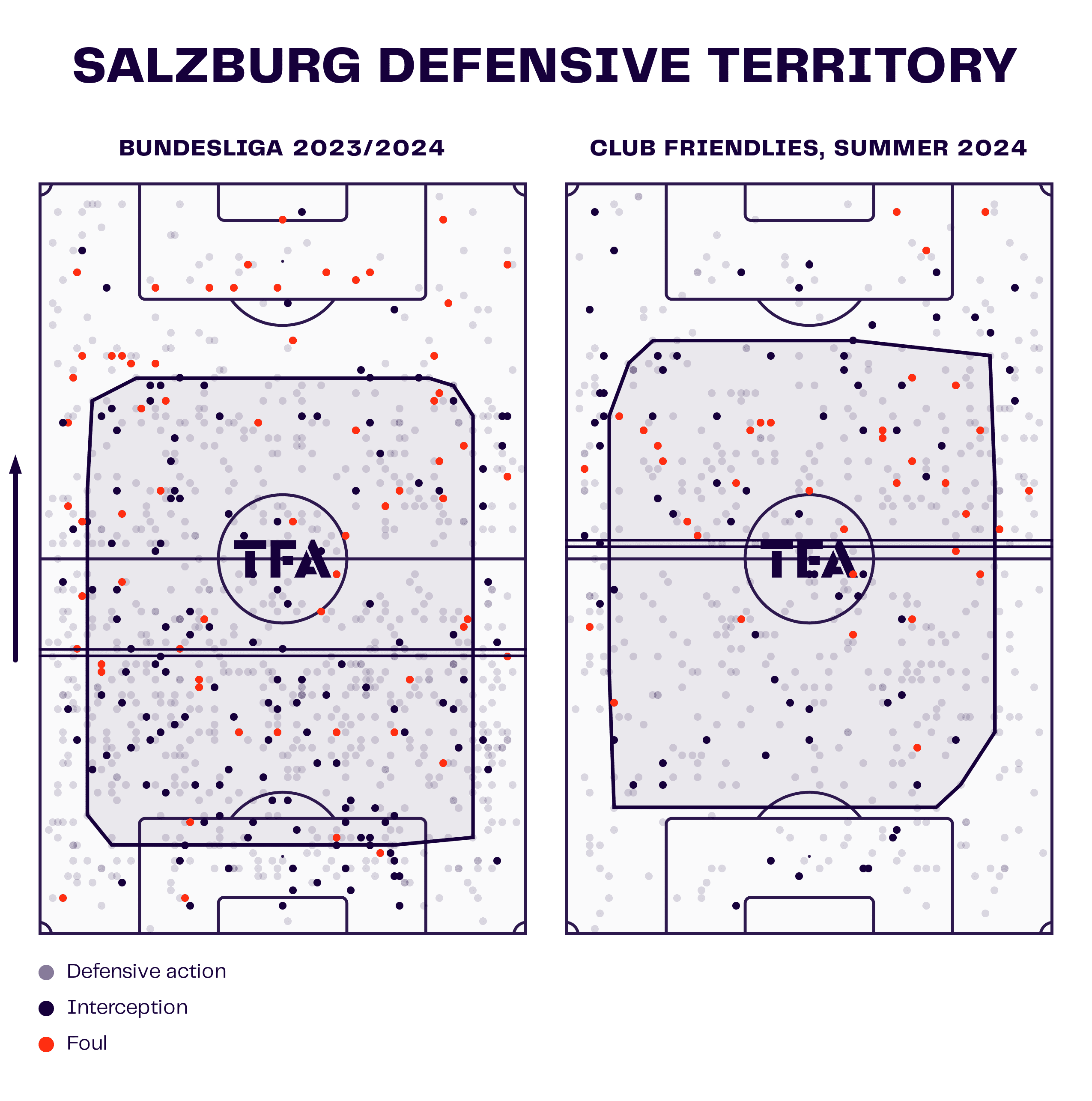
Knowing that Salzburg had the lowest PPDA in Austria’s top-flight last season, Lijnders is coming into a side full of players very familiar with pressing aggressively, which should suit him well.
However, the players will still have to take some time to adjust to Lijnders’ specific style of pressing compared to that of his predecessors.
The above visual is split into two, with the left showing Salzburg’s defensive territory from last season — useful for comparison with Sturm Graz in figure 1 — and the right-sided image showing their defensive territory from their 2024 summer friendlies under Lijnders.
Obviously, we can immediately see an incredibly high line being played under Lijnders, but that’s especially to be expected in summer friendlies against opposition not always of Austrian Bundesliga standard, to say the least.
So this image is not included to show a direct comparison between the two maps by themselves, so to speak, as much as it is to highlight the continuation of Red Bull Salzburg’s aggressive pressing philosophy.
So, what will change from last season to this season?
Well, in a 2022 interview with ‘The Coaches’ Voice’, Lijnders talked about his and Klopp’s interpretation of ‘pressing’ with Liverpool, stating:
“Our idea of pressing is not to force them one way or force bad passes. Our idea of pressing is to steal the ball—to steal the ball, attack, and create.”
This description embodies everything Klopp’s Liverpool was about and makes them unique, especially without the ball, with how they’d swarm the ball carrier and the options around them in packs.
We’ve already seen Salzburg start to play in this manner in their early games under Lijnders, and we can expect this to be a notable trend in their tactics moving forward.
This should grow into a highly useful tactical weapon for stopping opposition attacks and creating goalscoring opportunities of their own the more they get practice of playing in this way under their new manager.
Playing under Lijnders will require discipline and a high level of physical fitness, but with the quality young players at the 41-year-old coach’s disposal and a pre-existing culture of pressing with aggression and commitment without the ball embedded within the DNA of Red Bull Salzburg, the ex-LFC coach should be well able to mould something fit for his vision at Red Bull Arena.
Sturm Graz In-Possession
Now, as for Sturm Graz’s tactical approach with the ball, again, we start with a base of a team lining up in a 4-diamond-2 structure, as depicted by our tactics board in figure 3.
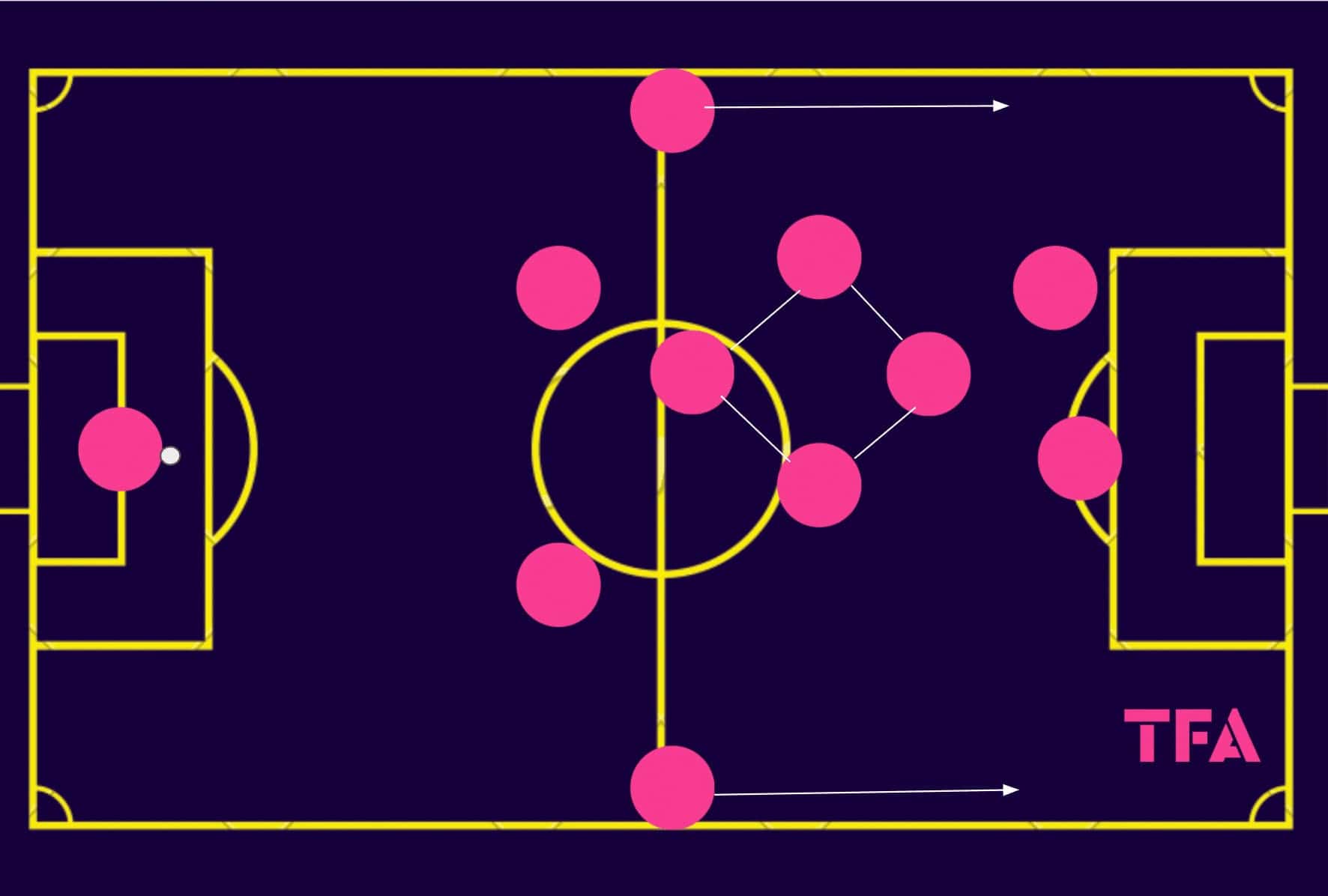
The central quartet will typically remain relatively close to one another in the middle of the park.
At the same time, the full-backs advance to offer the team width in possession.
At the same time, Sturm Graz’s striking duo will not sit flat alongside one another, with plenty of movement required from the team’s attackers in order to keep the opposition defence busy at all times.
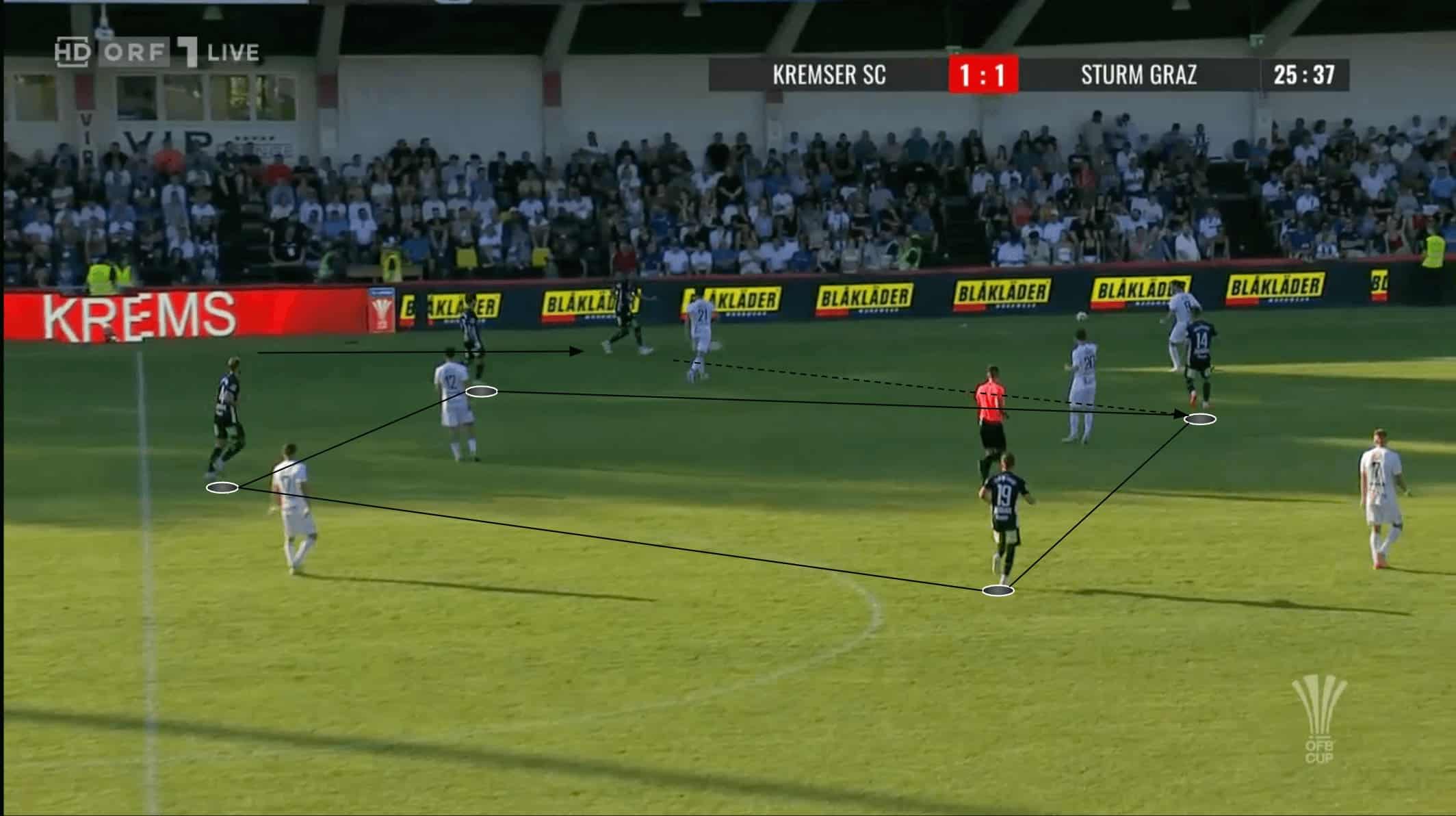
This connection from the full-back to the ‘10’ or a wide central midfielder is common within Sturm Graz’s game due to the full-backs often enjoying plenty of space out on the wing to receive early.
In contrast, the advanced central midfielders’ close proximity to one another and constant movement tends to free up one of them to become a decent progressive passing option for that wide ball carrier, as was the case in this example.
Figure 4 also highlights the way in which Sturm Graz’s midfield quartet will position themselves in relation to one another in the middle of the park, creating plenty of natural passing angles between themselves and their other teammates thanks to their diamond shape.
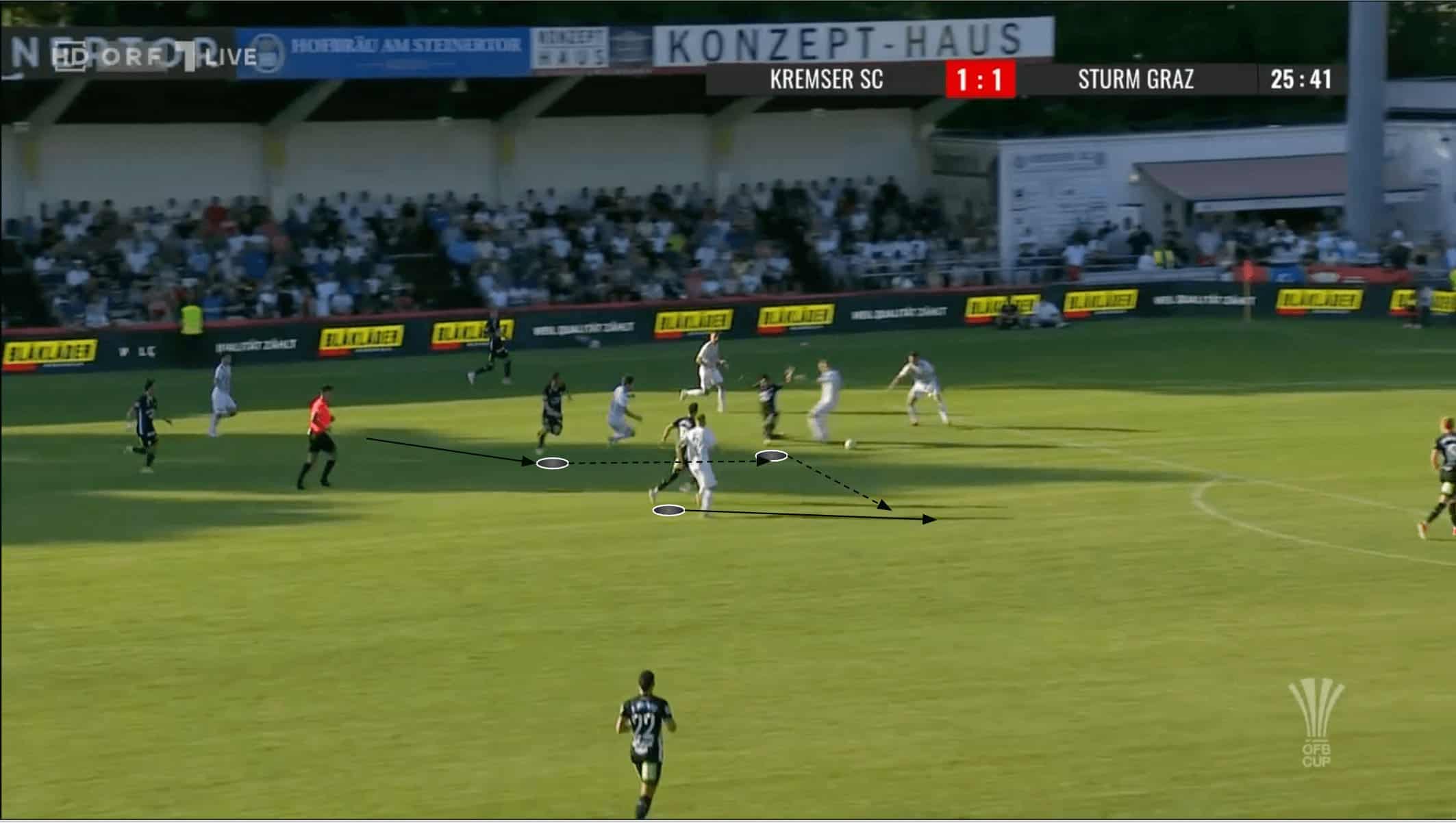
After the ‘10’ received on the half-turn and began carrying the ball forward, the left striker dropped and made himself an option for the ‘10’ to link up with.
The left forward knocked the ball onto the right central midfielder, who arrived in an advanced position from deep.
On this occasion, the left forward played a crucial role in getting his side into the final third and a decent attacking position.
This is a prime example of how Sturm Graz’s close proximity (while still respecting each other’s need for a reasonable amount of space in which to operate) in the middle of the park can facilitate very effective, quick passages of intricate link-up play capable of carving the opposition wide open.
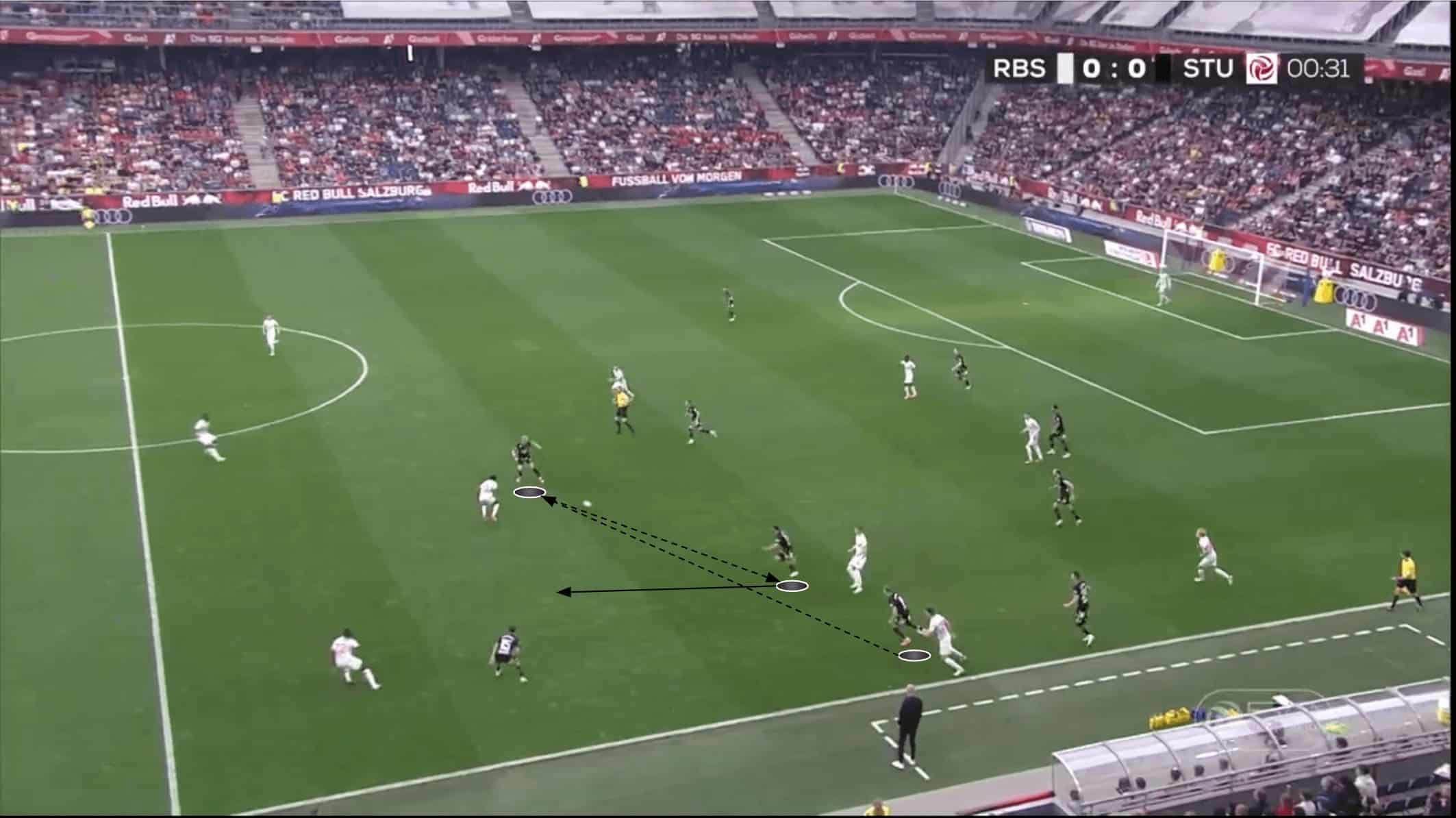
As figure 6 shows, Ilzer also relies on his full-backs to receive and kickstart counterattacks.
On this occasion, it’s the right forward dropping in to receive.
As he picks up the ball, he can quickly lay it off to the ‘10’ arriving into space just next to him, allowing Sturm Graz’s transitional attack to swiftly progress.
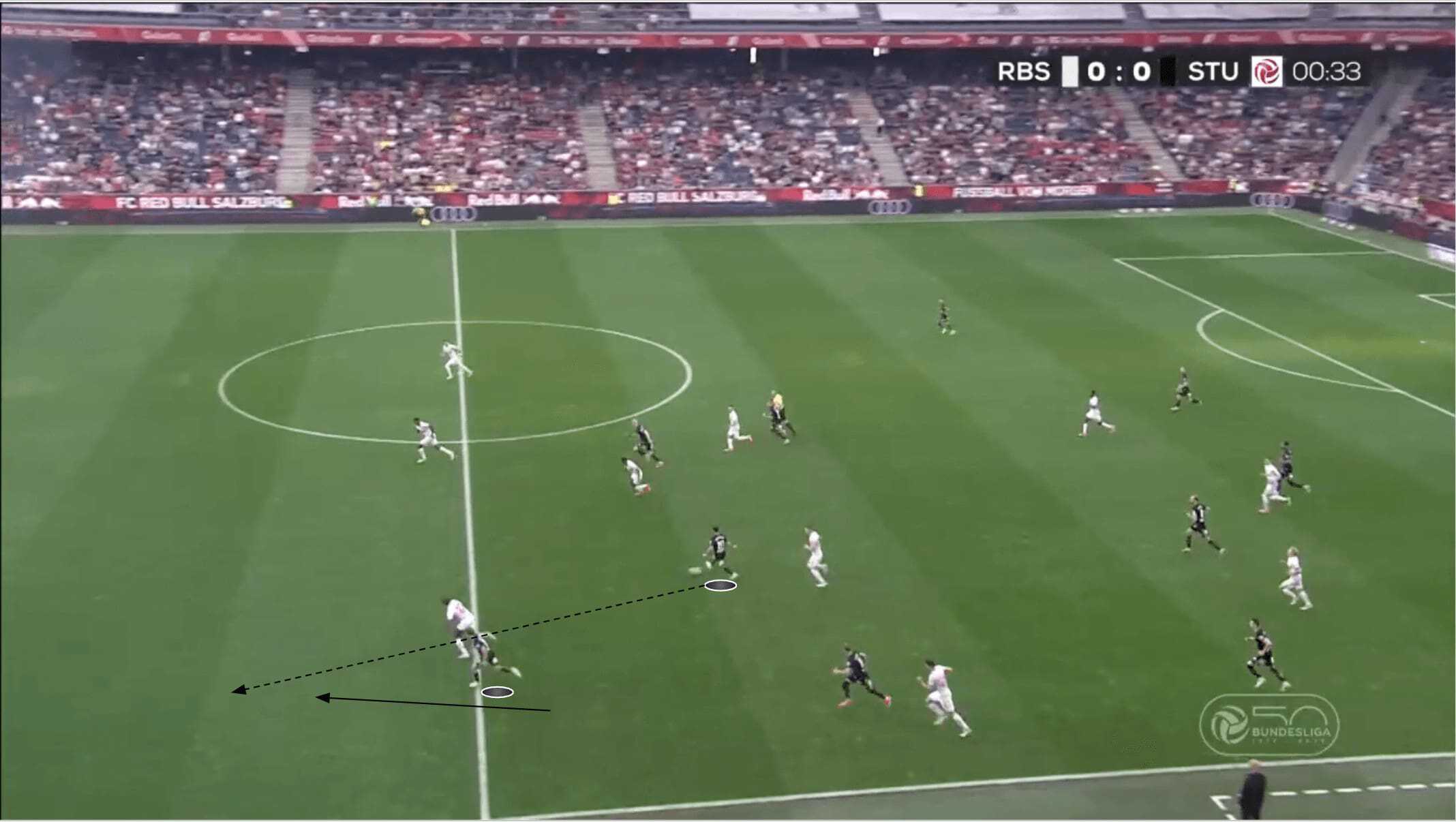
As the ‘10’ receives, Sturm Graz’s left striker makes a killer run in behind the opposition’s backline, which the midfield playmaker spots and can immediately try to take advantage of.
As the ball is played through in behind, the forward can chase it down and try to finish the job of quickly getting his side into a good goalscoring position on the counter.
To sum up, all of Sturm Graz’s players have a role to play in their possession game, characterised by their midfield diamond and the dynamics it creates.
Red Bull Salzburg In-Possession
Once again, there’ll be plenty more to unpack about Lijnders’ Red Bull Salzburg as time progresses, and he has more time to work with his players on the training ground.
Still, we’ve observed some clear tactical patterns in possession worth mentioning in this section of analysis.
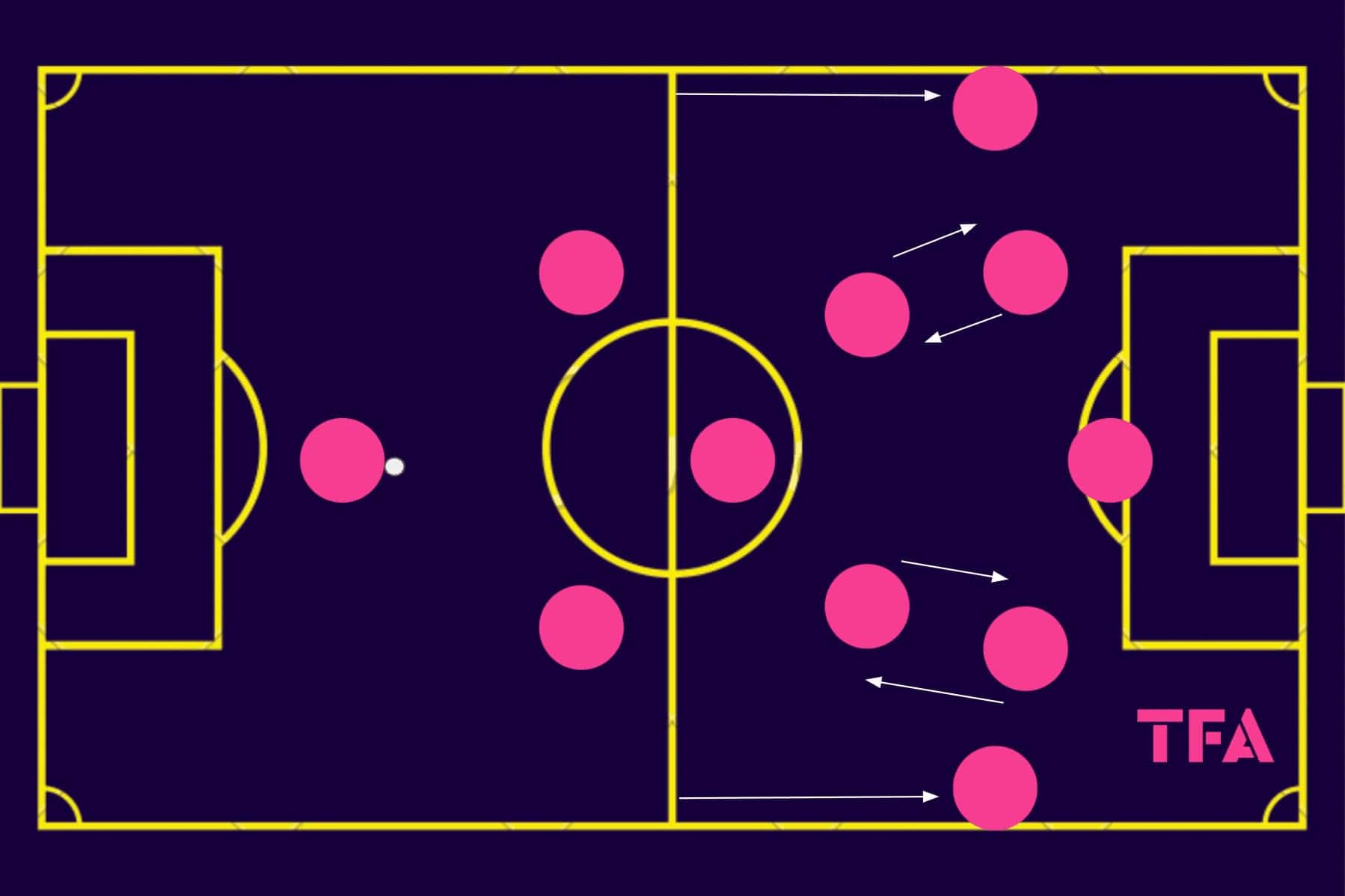
Firstly, Lijnders’ Red Bull Salzburg have primarily utilised a 4-3-3 shape.
In possession, his wingers have been coming a bit narrower, the full-backs have been advancing on either side, and there’s been plenty of central movement, with the wingers and central midfielders rotating at times.
In addition, Salzburg’s goalkeeper has clearly been getting heavily involved in the play outside of his box, adding an extra body to the first line of possession in many cases.
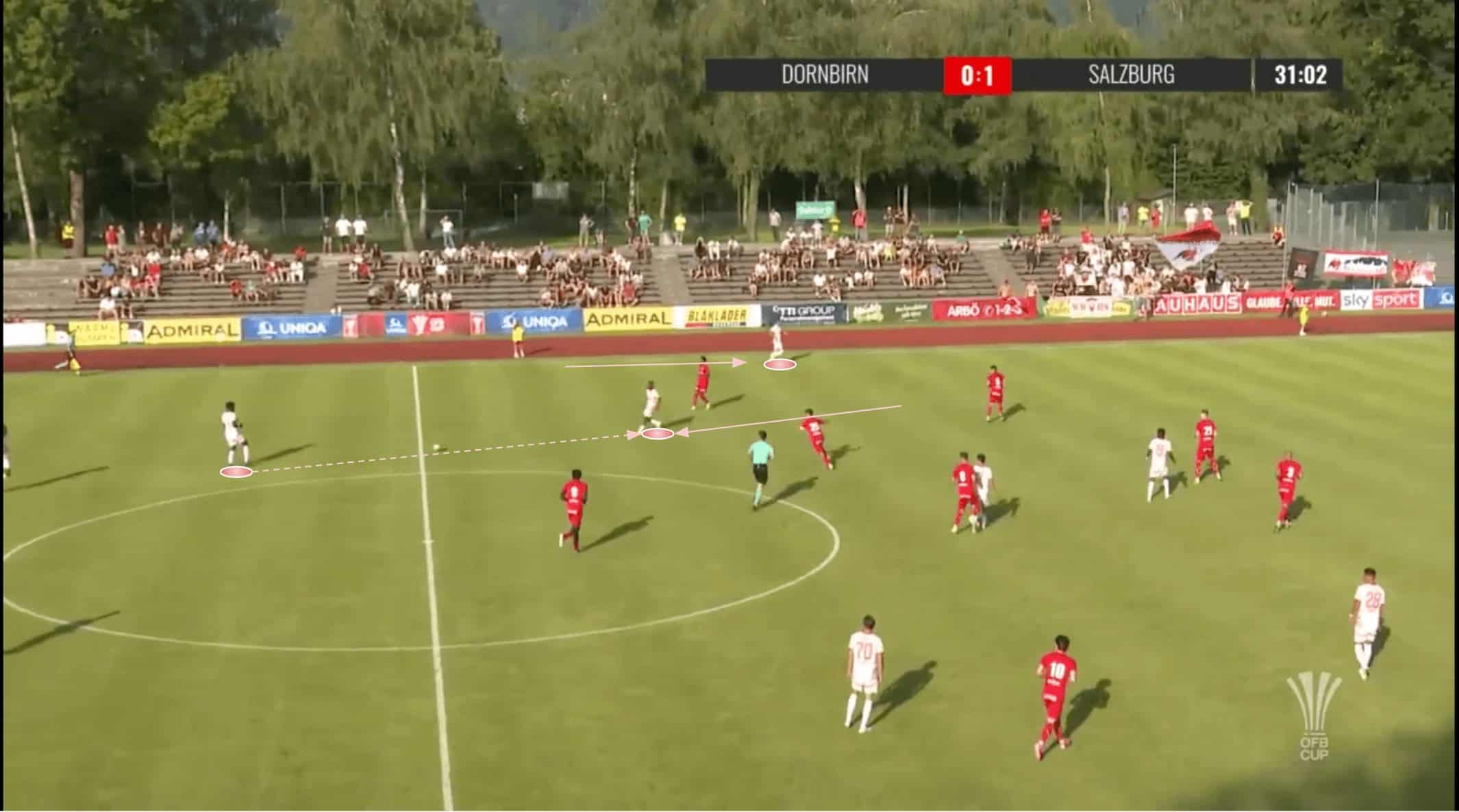
In this case, shown in figure 9, the holding midfielder — Mamady Diambou — passes to the left-winger — Dorgeles Nene — as he drops deep into more of a left central midfield position.
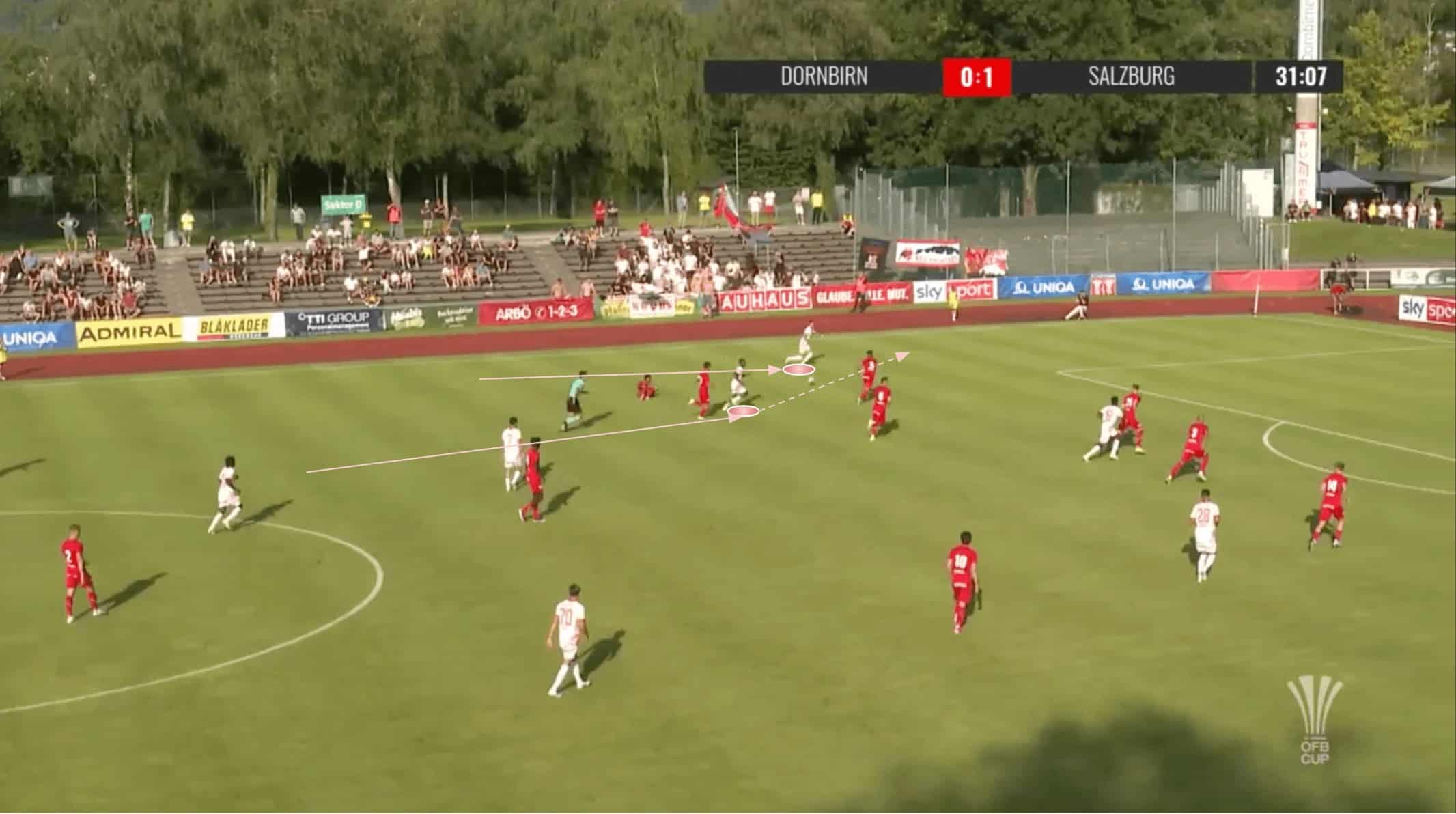
As this play moves on, we see how Nene has turned and dribbled forward a few yards before he plays a through ball to the overlapping full-back, Aleksa Terzić, out on the left wing.
It’s been common to find Lijnders’ full-backs pushing right up to the top of the pitch, really offering a tonne of width in the final third and probably getting involved higher more often than Sturm Graz’s full-backs, who had a more significant role in ball progression.
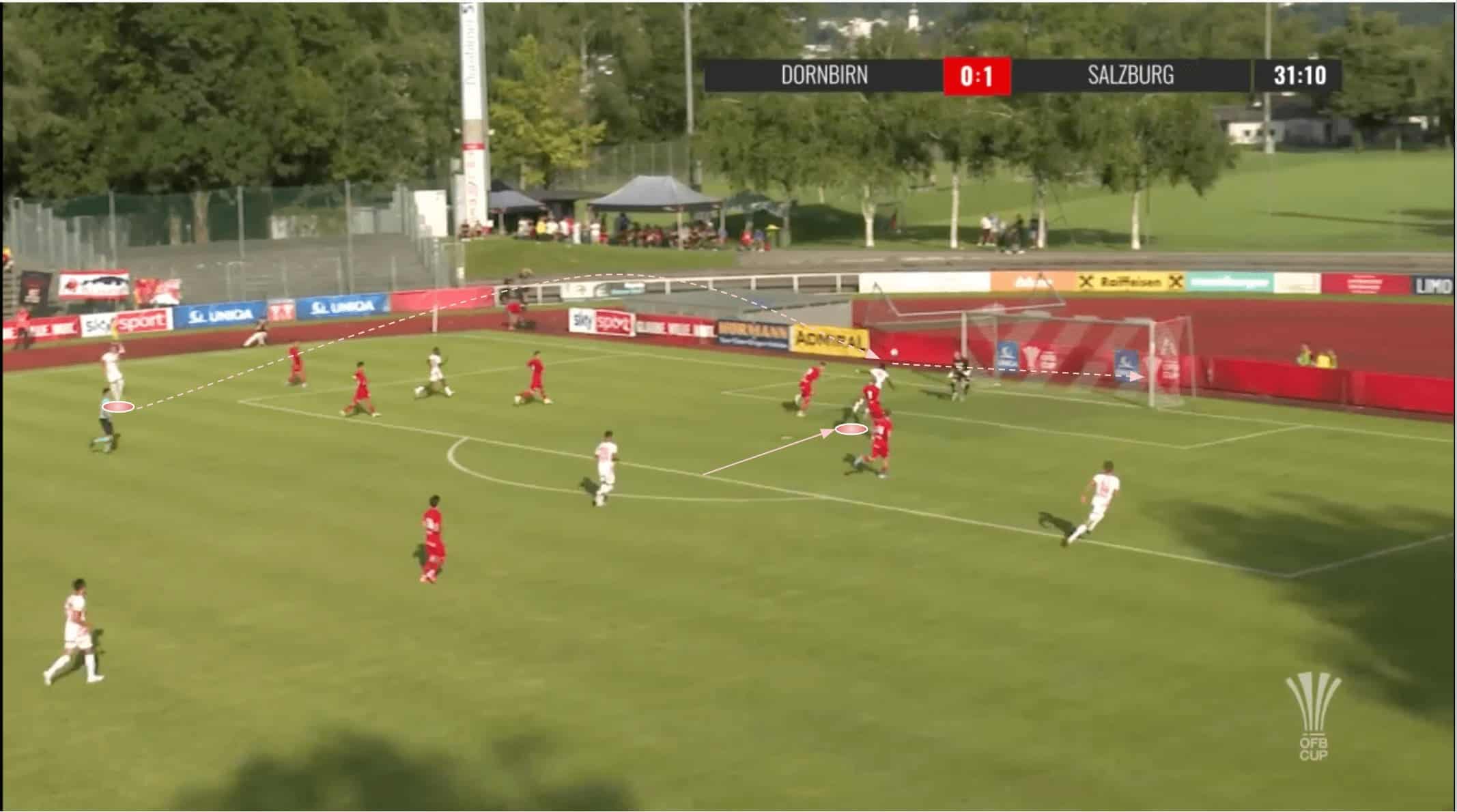
Finally, Terzić has time and space to swing a beautiful cross into the danger zone for centre-forward Karim Konaté to finish the move off with a nice header, which rockets the ball beyond the opposition goalkeeper and into the back of the net.
Indeed, Salzburg’s full-backs will likely continue to play an active role in chance creation under Lijnders.
With that, they expect crossing to be a key component of their approach to finishing off attacking manoeuvres.
Additionally, Karim Konaté is a well-rounded centre-forward who’ll provide an excellent focal point to Lijnders’ attack.
Thanks to his movement and positioning, he can take advantage of opportunities from high-percentage goalscoring positions.
Figure 12 shows Red Bull Salzburg in the progression phase while playing with a double-pivot.
Lastly, while Salzburg have primarily played with a single pivot in the 4-3-3 under Lijnders thus far, there have been occasions when they opted for a double-pivot and the 4-2-3-1 shape instead, with figure 12 providing an example of the Austrian giants in this shape.
The full-backs still play a key role in attack when this occurs, while the wingers still come into the half-spaces.
The main difference is how the rotations with the central midfielders works.
In this case, there may be some rotation between the wingers and ‘10’, though the ‘10’ might also rotate with the centre-forward in this shape.
Either way, this shape will provide a solid base of 2-2 with the centre-backs and holding midfielders stationed at the base of midfield or 3-2 when the goalkeeper advances out.
This shape has been used a lot less than the 4-3-3 in the early days of Lijnders’ Salzburg but we see it being used at least sporadically during the Dutch coach’s tenure.
Conclusion
To conclude this head coach analysis piece and season preview for the 2024/25 Austrian Bundesliga campaign, we don’t see Sturm Graz changing a tonne from what’s worked well in recent seasons in terms of their overall game model.
Of course, specific player roles and responsibilities will be adjusted based on the new additions to the squad which will provide the necessary tactical tweaks to keep opponents guessing.
These may well be worth analysing in greater detail as the season progresses.
On the other hand, Salzburg will undergo a slightly more significant tactical overhaul while still adhering to the overall principles we’ve come to associate with a ‘Red Bull’ side.
Again, with Lijnders only in the very early days of his time as Salzburg boss, we anticipate that there’ll be a lot more to analyse from the Dutchman as time progresses and we get deeper into his time in charge at the club.
Still, the early days of his tenure have provided plenty of food for thought and tactical discussion as we approach the beginning of this highly anticipated Austrian Bundesliga campaign.

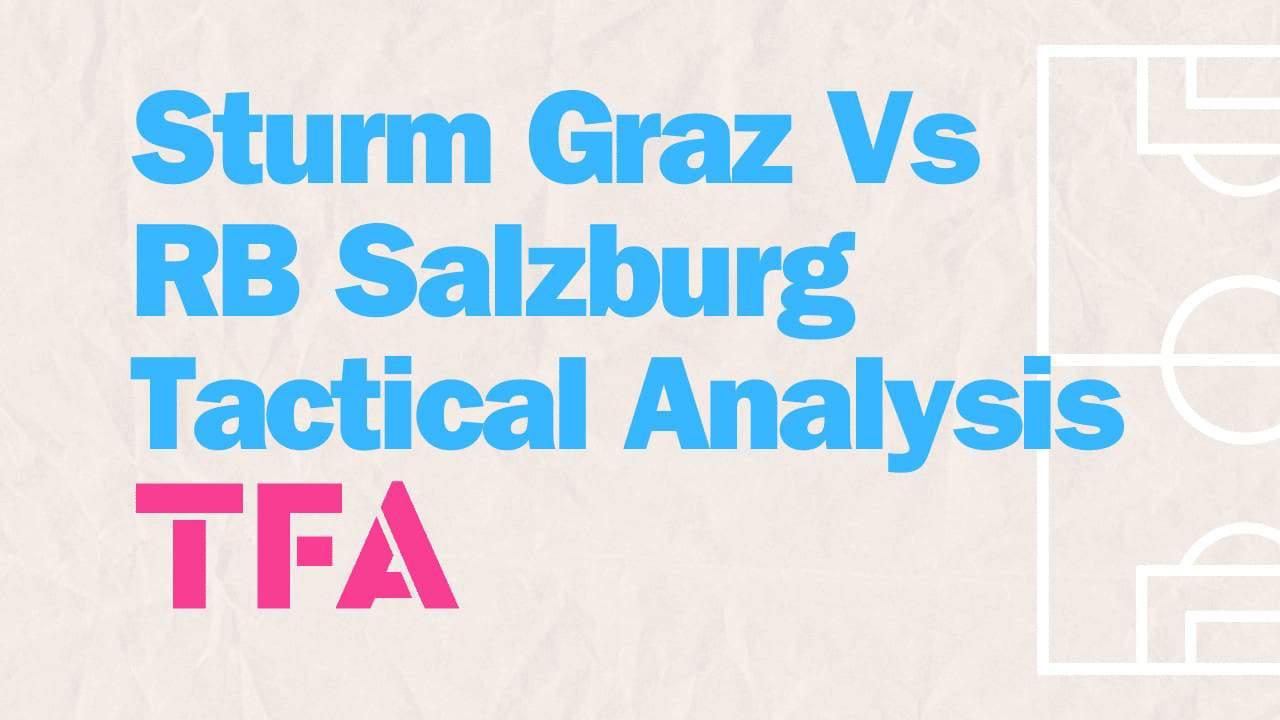



Comments